 |
||
|
||
| ||
Contents
Today we present an unusual article. Firstly, we'll examine an original ASUSTeK creation – some hybrid of the GeForce 6800 series. Secondly, we are very curious to compare GeForce 6800 cards with various memory capacities, because this question is still a subject of much controversy among users and our readers. But at first let's lament once again over the fact that autumn has come, but the mass sales of various GeForce 6800 cards are not yet to be seen. Sales volumes are rising very slowly, mainly of 6800. To say nothing of 6800 Ultra, this product is extremely rare. But we hope that in the long run NVIDIA together with IBM will deal with their problems, and the entire 6800 series will be openly on sale (if you have the money, of course!) Though we are not reviewing exactly GeForce 6800, the core is still from 6800. And thus, all our previous articles devoted to the NV40 features may be of help to those who go into these video cards starting only from this article.
Theoretical materials and reviews of video cards, which concern functional properties of the GPU
It's interesting to note that ASUSTeK, having previously been a leader of NVIDIA and having been practically the first to manufacture new video cards, is now an obvious outsider. Almost all NVIDIA partners "have already fired", but the Taiwanese company with a rainbow logo is not making any progress with new video cards based on GeForce 6800. And only in autumn the ice has been broken. Interestingly, five (!) months have passed from April 13 to September 13, but the GeForce 6800 video cards are only beginning to be released by some partners. That's almost half of the year! In good old times this period would have been enough for the product sales to pass their peak and be on the wane, because of the coming announcement of a new product. Unfortunately, the situation of ATI the Canadian company is not better: they only have X800 PRO. And this card is obviously overpriced, because wasting almost $500 for the card, which is evidently weaker than GeForce 6800GT (about $450 in early September), is a stupid thing. Why such prices? - Deficit. Even X800 PRO is not produced in sufficient quantities to satisfy the demand. Darned demand... It resembles a whimsical young lady. In old days cards for $450 were getting dusty on the shelves and no one looked at them because they were considered very expensive! And now people are standing in queues for 600-dollar accelerators, and even get listed in the wait lists. And what concerns X800 XT, to all appearances it's doing even worse than NVIDIA with its GeForce 6800 Ultra. Perhaps the production percentage of good chips with all 16 pipelines operational is really very low. Moreover, the reason for X800 PRO VIVO appearing on sale is that many X800 XT are not capable of operating at the regular 520/1120 MHz frequencies, and they are "disrated" to X800 PRO (because there are no intermediate models between them in the AGP series). After their reconstruction into X800 XT, such cards are capable of working with 16 pipelines, but the core often does not support even 500 MHz frequencies. But let's not digress. However considering that ASUSTeK also manufactures video cards based on X800, it's not much of a digression :). But today the subject of our review is another video card. A very interesting one! Just imagine, take a PCB from 6800 Ultra, equip it with GDDR3 2.0ns (as in GeForce 6800GT and in many "Ultras") and the GPU from GeForce 6800(!), and set the frequencies as in GeForce 6800GT (350/1000 MHz). You'll get a hybrid-mutant like our card under review. Let's have a look at this prodigy of nature.
Video card
As I have already mentioned above, this video card is based on the PCB from GeForce 6800 Ultra and thus has two connectors for external power supply. What's this for? Well, first of all, pay attention that the card is equipped with 256 MB of memory, even with GDDR3. Besides, the frequencies are raised to 350/1000 MHz. Will it be of any help to the 12-pipeline chip? In a regular GeForce 6800 the memory operates only at 700 MHz – the difference is huge. We have recently reviewed GeForce 6800 with modified memory frequencies and drawn a conclusion that this memory throughput at 700 MHz is quite sufficient even to feed the 12-pipeline chip in all modern applications, if not take into account AA modes at high resolutions. It's a paradise for such a GPU – the memory bandwidth is so wide that the bottleneck will most likely be the GPU itself in all modes (of course, if the CPU is not interfering). This will water overclockers' mouths, the chip can be overclocked to obtain high performance gain. Secondly, the Gamers Edition suffix. This little-explanatory term definitely means concern for overclockers. The regular GeForce 6800 has a simplified PCB and the power is supplied in a different way. It's not up to much overclocking. But here everything speaks for the fact that you can provide the power supply for the chip as in GeForce 6800 Ultra, there are no problems on the hardware level – the PCB is taken from Ultra. Plus increased operation stability due to the separation of power cables (the current does not run along a single cable). Thus, we have almost GeForce 6800GT, but with 12 instead of 16 pixel pipelines and with 5 instead of 6 vertex ones. To make sure of it, you only need to remove the cooler and look at the label, you will see GeForce 6800:
Here are RivaTuner results: 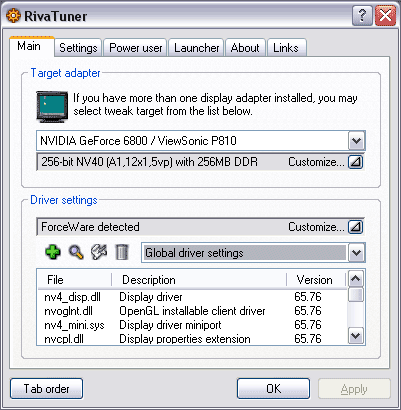 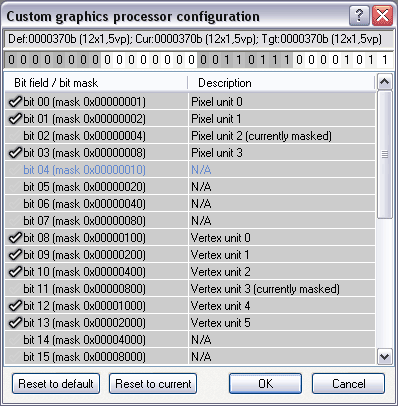
Unfortunately, all disabled pipelines are blocked on the hardware level, and thus we didn't managed to obtain more than 12/5 pipelines.
However, it should be noted that the PCB is not an exact copy of the reference design, because ASUS modified either the location of thermodes or the thermodes themselves, because neither NVIDIA drivers nor RivaTuner can monitor video card's operating temperature. The only help here is the SmartDoctor utility from ASUS: 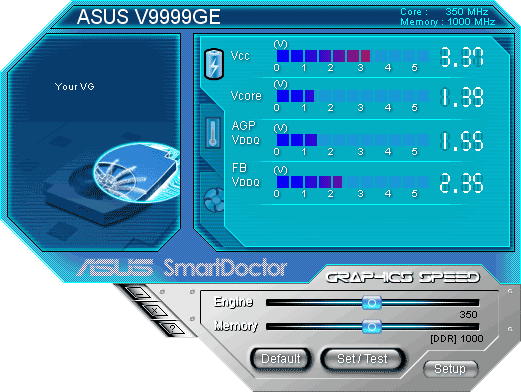 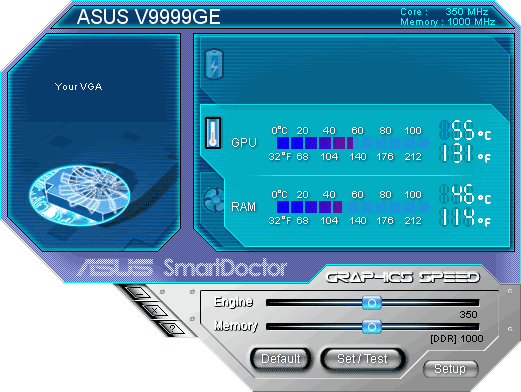 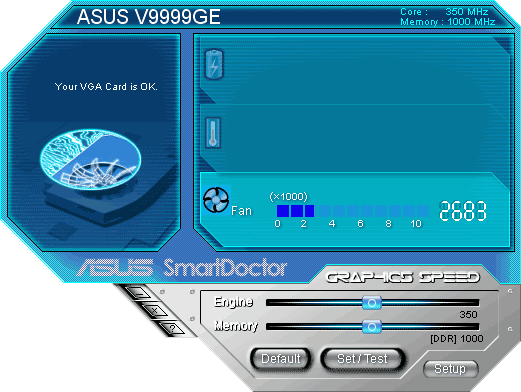 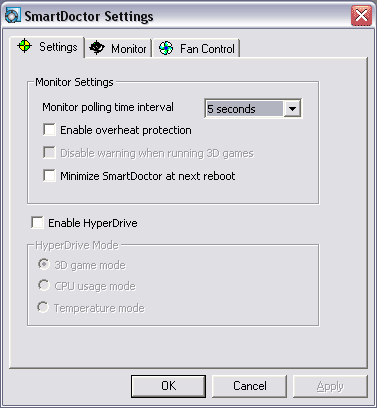 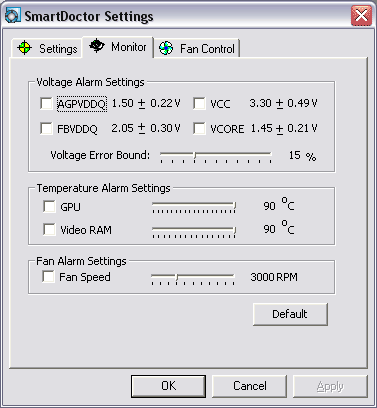 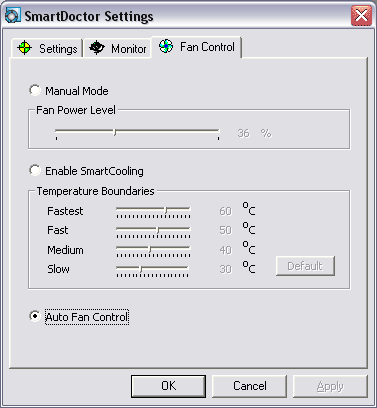
This powerful program will provide you with information not only about the temperature but also about the fan speed as well as about the core and memory chip voltages. Unfortunately the program only displays the current values, it does not support logging and plotting parameter curves.
Let's have a look at the cooling system
To continue the topic I want to show how this device looks when illuminated: The size of the cooling system should be noted as another positive moment, because it does not block the PCI slot next to AGP:
Let's see what's inside the package.
And now, let's have a look at the box itself: Now what concerns overclocking. The card easily operated at 465/1150 MHz, but overclocking was not exactly what I was interested in. I wondered at what frequencies the card would reach the performance of GeForce 6800 Ultra! These frequencies appeared to be 455/1150 MHz. I'll provide the details below. Installation and DriversTestbed configurations:
VSync is disabled. It should be noted that both companies have enabled trilinear filtering optimizations in their drivers by default.
In order to compare with GeForce 6800 128MB, I tested the card from ASUS at 325/700 MHz. The results can be seen on the diagrams below. Plus, though RADEON X800 PRO refers to more expensive video cards, I was interested in comparing ASUS V9999GE with this product as well, especially as the first prices for V9999GE will most likely be almost on the level with X800 PRO (deficit!).
Besides, as I have already mentioned above, I was curious to compare the operation of ASUS V9999GE at 455/1140 MHz with that of GeForce 6800 Ultra.
And the results of RADEON X800 XT PE, GeForce FX 5950 Ultra, and RADEON 9800XT are provided just for the sake of interest.
Test resultsBefore giving a brief evaluation of 2D, I will repeat that at present there is NO valid method for objective evaluation of this parameter due to the following reasons:
What concerns the combo of our sample under review and Mitsubishi
Diamond Pro 2070sb, this card demonstrated the excellent
quality in the following resolutions and frequencies:
Test results: performance comparisonWe used the following test applications:
If you want to get the demo-benchmarks, which we use, contact me at my e-mail. In the diagrams with the ANIS16x (AA4x+ANIS16x) caption the video card based on GeForce FX 5950 Ultra was tested in the ANIS8x (Quality) mode, the other cards – ANIS16x (Quality)
Serious Sam: The Second EncounterThe easiest modes without AA and anisotropy: the product from ASUS is approximately in the middle between 6800 and 6800GT, which is quite expectable. Approximate parity with 6800 128MB at equal frequencies: 256 megabytes did not yield any dividend. Overclocked to 455/1140 MHz, the card just reached the speed of 6800 Ultra. The final heaviest mode with AA and anisotropy: What concerns the comparison with 6800 and 6800GT, the picture is the same, only the contrasts got increased. V9999GE at the 6800 frequencies is slightly outscored by its competitor (perhaps the effect of different memory timings). On the whole one can say that 256 megabytes gave nothing to 6800. Overclocking to 455/1100 MHz also provided the speed equal with 6800 Ultra. Thus, on the whole:
Just imagine: the fillrate of 6800 Ultra: 400 x 16 = 6400 megapixel/sec. And the fillrate of the V9999GE with its core overclocked to 455 MHz: 455 x 12 = 5460 megapixel/sec. It's obvious that the latter figure is considerably less than the former. Plus, the 6800U memory frequency is 1100 MHz, while the overclocked V9999GE – 1140 MHz. Perhaps, 6800U has already reached its maximum memory bandwidth to let a video card with a lesser fillrate and a raised memory frequency catch up with its performance.
Code CreaturesThe easiest modes without AA and anisotropy: V9999GE is still in the middle between 6800 and 6800GT. We can also see approximate parity of this card with the 6800 128MB at equal frequencies (the extra memory capacity gave nothing). Overclocking to 455/1140 MHz still results in parity with 6800U. The final heaviest mode with AA and anisotropy: Though it's expectedly outscored by the 6800GT, its victory over the 6800 128MB is impressive. Comparison of the cards at equal frequencies confirms that 256 MB provides the ASUS product with considerable performance gain. Especially at 1600x1200 (though in this mode the speeds are below the playable level). Comparison of the overclocked V9999GE with the 6800U revealed nothing new: their performance is completely matching. Thus, on the whole:
Unreal Tournament 2003The easiest modes without AA and anisotropy: V9999GE is also between 6800/6800GT. Reducing the operating frequency to the level of 6800 128MB gave nothing new (approximate parity, slightly lagging behind the 128 MB video card, probably because of the different memory). Raising the frequencies to 455/1140 MHz increased the video card's performance to the level of 6800U. The final heaviest mode with AA and anisotropy: comparison with the 6800 128MB again demonstrated that the additional memory capacity is required only at 1600x1200 (but it should be noted that the gameplay is still on the sufficient level here). Comparison of the overclocked video card with the 6800U revealed nothing new. Thus, on the whole:
Unreal II: The AwakeningThe easiest modes without AA and anisotropy: Completely the same picture. The final heaviest mode with AA and anisotropy: the same picture. There is nothing to add. Thus, on the whole:
RightMark 3DThere is even nothing to comment: the extra memory capacity in V9999GE again reveals itself only at 1600x1200 with AA and AF. The parity remains between the video card from ASUS at 455/1140 MHz and the 6800U. Thus, on the whole:
TR:AoD, Paris5_4 DEMOThe same picture, only the contrasts got bigger (larger speed difference between the competitors). 256 megabytes in V9999GE still have their effect only at high resolutions with AA (when the gameplay is horrible). Thus, on the whole:
FarCry, demo01No comments: the situation resembles the previous one. Thus, on the whole:
Call of Duty, ixbt04The easiest modes without AA and anisotropy: it's difficult to compare because the performance here in many respects depends on the CPU capacity. The final heaviest mode with AA and anisotropy: it's interesting to note that the V9999GE, operating at the same frequencies as the 6800 128MB, was outscored by the latter at the same 1600x1200 resolution with AA+AF. This is even strange. There must have been at least approximate parity. But we can see that the 6800 128MB is a tad faster in all tests. This fact can be explained only by the different memory timings and the drivers. This game is not so critical to video cards, and so a more important role here is played by the CPU and software issues, including drivers. Thus, on the whole:
HALO: Combat EvolvedThus, on the whole:
Half-Life2 (beta): ixbt07 demoAnisotropy mode: The V9999GE gained a small victory at the frequencies equal with the 6800 128MB. But it is too minor a victory to pay attention to. The competition between the V9999GE 455/1140 MHz and the 6800U is strikingly stable: parity again. The final heaviest mode with AA and anisotropy: simple parity of potentials here, besides competing with X800 PRO Thus, on the whole:
Splinter CellThus, on the whole:
Return to Castle Wolfenstein (Multiplayer)The easiest modes without AA and anisotropy: it's all up to the CPU, so it's almost impossible to compare. The final heaviest mode with AA and anisotropy: nothing new. V9999GE 325/700 MHz is still a tad behind the 6800 128MB, but at 455/1140 MHz it's almost equal to the 6800U. Thus, on the whole:
Quake3 Arena
The picture is absolutely identical to the previous.
DOOM IIIThus, on the whole:
ConclusionsSo, we have reviewed a very interesting video card. As I have already written before, ASUS V9999 Gamer Edition is a hybrid between the three representatives of the GeForce 6800 series: the core from the 6800, the frequencies and the memory capacity from the 6800GT, PCB from the 6800Ultra. The video card is very good and may interest overclockers (we managed to obtain the operating frequencies of 455/1140 on our sample video card, quite enough to reach the performance of 6800 Ultra). Comparisons of the 6800 video cards with different memory capacities demonstrated that the 256 MB are useful only at 1600x1200 with active AA. But the gameplay in such modes in modern games is as a rule below critical and is not of practical interest. The video card is very stylish, it features illumination (owners of open or semitransparent PC cases should rejoice), perfect workmanship, and the operating stability proved in our tests – these are the pros. Plus versatile monitoring via the SmartDoctor utility (though the program has its drawbacks). That's on one scale. Plus a decent addon in the form of a victory over X800 PRO in some games. On the other scale is just... a price. For now, in mid September, it costs $480-500, which is certainly no go, because GeForce 6800GT (which is surely faster) can be bought at a smaller price. Let's hope that this, ahem, behavior of trade organizations will change and the prices will go down to the affordable level (about 400 dollars). At least all these luxurious bundles and illumination must not raise the prices higher than those for models, which are senior in performance.
In our 3Digest you can find more detailed comparisons of various video cards.
According to the test results, ASUS V9999 Gamer Edition gets the Excellent Package award (September). 
As well as the Original Design award (September). 
Write a comment below. No registration needed!
|
Platform · Video · Multimedia · Mobile · Other || About us & Privacy policy · Twitter · Facebook Copyright © Byrds Research & Publishing, Ltd., 1997–2011. All rights reserved. | ||||||||||||||||||||||||||||||||||||||||||||||||||||||||||